Grace Neutral, London
The Instagram revolution has changed tattooing. There was an old white man biker mentality when I started out – they were the gatekeepers. There was sexism, racism and an old boys’ club. Apprenticeships in these shops were the only way you could make a name for yourself and get a job. We now have the ability to advertise ourselves. That’s what I do to my 500,000 Instagram followers.
But, I still believe in traditional tattooing values. There used to be a mystical magic about it, which doesn’t exist any more. The secrecy brought about tight-knit communities within the industry. It is almost like having a family. The Internet allows us to do our own thing and go it alone. It is vital to me that we continue to foster this sense of community. Because being a woman in tattooing – I was only 18 when I started out – was pretty tough.
I’d always been fascinated by body modification, whether with ink or piercings. Through my teens, I was tattooed. Mum had books in her art studio on body modification – I’d flick through and see these images and was enamoured by the beauty of it all. I was raised in Plymouth and quit school before GCSEs. I did a lot of work at an art college but never found a purpose. My friend, who was 15 years old, asked me to book her an appointment for a tattoo. I popped into the shop to do it, and got one for myself as well – a heart on my leg. The addictive rush of endorphins and euphoria I felt afterward was overwhelming.
Back then, I didn’t think much about artistry or creativity. Only later – when I started to tattoo others – did I think more about my body as a canvas. That’s part of the evolution of the art. You can make new tattoos to cover old ones. Now, my legs are on the third layer.
I was 18, and was walking through Soho with my friend when I received a flyer about a tattoo studio. I walked in – with no experience – and asked for a job. I was offered a piercing apprenticeship. I borrowed the studio needles and printed out stencils. I didn’t want to stop after that.
It’s always been hand-poke I’ve enjoyed most – machines and I have never really bonded. I attach a needle to a piece wood for a handle, and then hand-draw each dot. I’m known for symmetry and geometric work, mandalas and patterns using shading.
The tattoo industry is growing. The industry is huge and it’s more accepted by society. Tattooists are celebrities. Put simply, tattoos got cool. People get tattooed for many different reasons: to heal or to rebel; for confidence, love or grief – but it’s always an expression of control. Of your body, of how you see yourself and how you’re seen, in a world where it’s hard to control anything.
I have a studio where I work three or four days a week, and we’ve got room for nine artists. We don’t have a shopfront – we rely on the internet, and word of mouth, for business. I give examples to people who come to me. They then allow me to get to work on their bodies. I am free to draw and design however I like. That’s how to get the best out of me as an artist.
Doy, Seoul (South Korea).
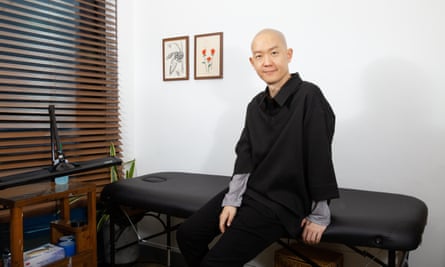
I’ve been tattooing in Seoul for 17 years, but the situation for artists like me here is complicated. It is a very restricted profession, and tattooists can be punished with heavy fines or even jail time.
In countries like Japan and Korea, tattoos have historically been linked to organised crime. Both countries had tattoos that were visible on the skin of criminals. These tattoos were hidden by criminals who used larger and more bolder tattoos. These results were vivid and large.
In the hopes of reducing violence, the government wanted to eradicate tattoo culture. The Korean courts declared tattooing a medical practice in 1992. To legally tattoo, you must be a licensed medical professional. It’s an entirely unnecessary law. In the past, it wasn’t uncommon to have resections on tattooing across the globe, but in the last 20 years that’s changed. Japan has also scrapped the equivalent law in 2020. Now it’s only Korea left lagging behind. It’s why for the past three years I’ve been working to build a tattooists’ labour union. We now have 750 members and are fighting to make tattooing legal all over the world. South Korea. However, a cultural shift is already taking place. It might be illegal, but it’s incredibly common. One in four Koreans is covered with some kind of tattoo. These tattoos can be seen on celebrities, politicians, and sports stars. One-third of all tattoos are done by women. [£600m] Industries in the country were forced underground. For me, it’s the battle of a lifetime. I was born in Korea and graduated from university with a degree in visual design. I worked for a while in UX design – but the job wasn’t paying enough, so I looked for other work. I was then introduced to tattooing 17 years ago.

Our style of tattooing is revered and copied around the world – we are pioneers. We use needles to create fine art on the skin’s canvas, with a focus on texture, shading and fine lines. The Korean art form of tattooing is well-known and widely accepted. When I’m in the US tattooing celebrities such as Lily Collins and Brad Pitt, they treat me like an internationally respected artist; on InstagramMy professional account has nearly 450,000 followers. Once I land in Korea and go through customs, it is clear that I have been convicted. Nearly every time, the government takes my needles and ink. Many tattoo studios are thus kept secret and hidden from the public.
I was convicted and fined for being a tattooist in 2021. I may still be sent prison. My case is a test for all sentenced persons: 25 lawyers are working on my appeal. Right now, our chances don’t look good – most of our constitutional court judges have already made clear they’re against us. Still, everyone sensible in Korea knows tattooing needn’t be criminalised. At the moment, there are at least six proposed laws that would legalize tattooing. It’s just that 12 years since the first was tabled, nothing has been voted through.
Make Break Remix by Fiona Bae: The Rise of K -style is now available
Cake, Brooklyn, New York
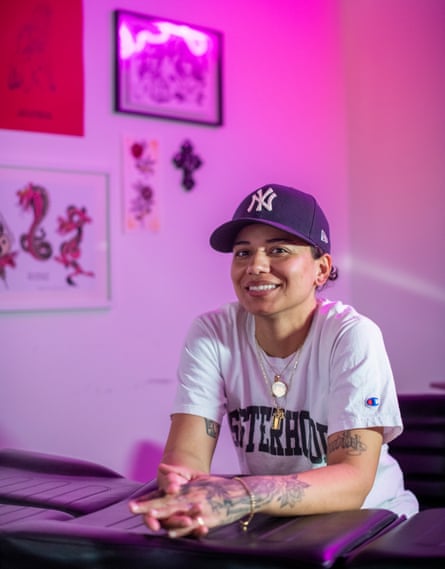
I did not receive any training. There was no mentorship or apprenticeship. I watched some videos on YouTube and ordered books. I learned as I went along. I’ve still had no formal training to this day. I’ve got a few tattooist friends, but I’ve never really felt I’ve fitted into the tattooing community.
Samantha Robles is my name, but I prefer Cake. This has been my preferred method of addressing people since high school. Supposedly it’s because I’m very sweet. My teenage years were difficult. I didn’t go to school and wasn’t studious. I dropped out of college almost immediately after my first day. When I was 18, I had begun getting tattoos. I’d always drawn and for a few years messed around giving tattoos to friends in our bedrooms.
I was curious to see how it worked and went to a shop to find out more. They were all white men, and I was dismissed. I struggled to find the confidence to ask again, so didn’t bother. I decided to keep it simple and create my own designs. Then I met my wife seven years ago – unlike me, she’s a goal-oriented, driven person. She encouraged me to take my work seriously. Step by step, I started to see the results. I now have people from all over the world coming to me to get their tattoos done.

The culture is changing and that’s important. I used to hear of people being attacked or subjected to violence and abuse by tattooists. And when I was coming up, we had black tattoo shops in the hood, and fancy white tattoo shops in the city – it was incredibly segregated. Thankfully, there’s a new direction now.
I’m still working out how tattooing translates into supporting my community, which for me is important. My art helped to raise funds for community fridges. When Hurricane Maria hit Puerto Rico, I made a sheet with specific tattoos that I offered to customers. All profits went to the relief effort. But as my work gets more popular, I’m having to grapple with how success fits.
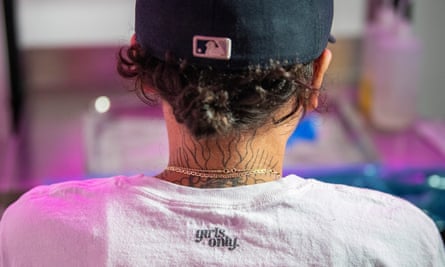
You can grow your business by raising your prices as an artist in high demand. If I was making a product, I could just produce more. My time is limited. Right now, my books are closed – it’s just too busy. I’m from the hood and don’t want to cut out the people from my community from accessing what I’m doing. I’m testing out free flash tattoo days for people on lower incomes; exploring how I might train others in this form of art. I feel guilty about tattooing as a transaction.
It’s funny. Tattooing scares us in some ways. It is a permanent tattoo that I find overwhelming at times. As I’ve gotten older, my appreciation of what giving a tattoo to someone means has grown. They’re choosing to give me a piece of their body – that’s a real responsibility.
Rebecca Vincent, London
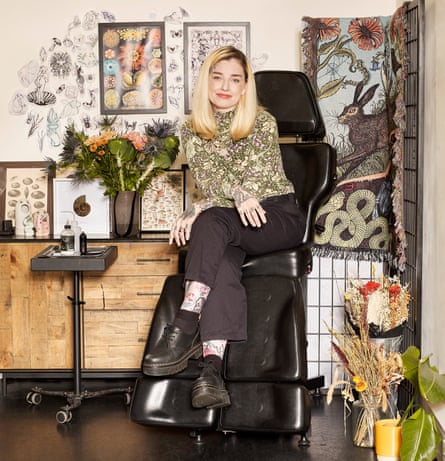
My average customer, a 38-year old woman, gets her first or second tattoo. They’re often at transformative moments in their lives: refinding themselves after early motherhood; hitting a big milestone birthday; navigating through a divorce. It’s all sorts: judges, vicars, teachers, doctors and nurses, and accountants. These are usually women who didn’t know tattoos were possible for them. Now they’re a little older, they’re taking control of their bodies – it’s an expression of freedom and autonomy. They’re celebrating their flesh and bones when some in society would have us think we’re over the hill. For me, it’s a pleasure to be part of their process of discovery and reclamation. That’s what tattooing offered me.
I’m from South Yorkshire originally. Prior to having my child, I worked as a waitress. When I got my first tattoo, I was only 20 years old. It was thrilling and allowed me to explore my body in new ways. For me – much like many of my clients today – tattoos helped me gain body-confidence, and boosted my self-esteem. Soon I was getting more. All things were fascinating to me, from the history and artifacts to the process. I don’t regret anything, each one is a good memory. It was around then I got the word “DINOSAUR” inked across my knuckles…
It was a great experience, but it made me nervous. There were these presumptions – stereotypes – about what it meant and what they made me. It even comes up in therapy: what do you think this tattoo “thing” is all about? It’s presumed to be a problem, especially for women. My parents weren’t impressed at first, although I tattoo my mum now. As is the age-old misconception, they thought it was all criminals or sailors. Although I was able to see things differently, I never thought I would be a tattooist.
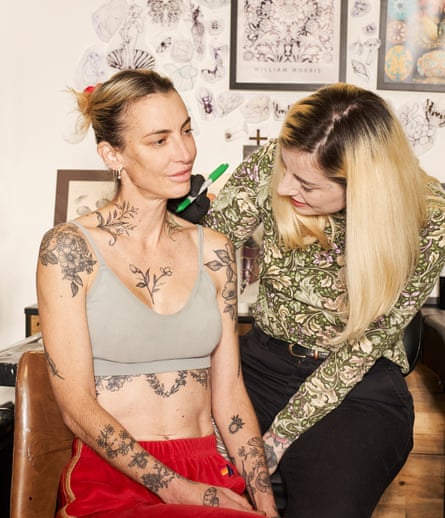
I then had a baby. I couldn’t go back to working in a pub – the hours just didn’t work with being a new parent. A friend suggested that I try tattoos. I was reluctant. I didn’t see a way in. And I’d neglected my own artistry for a decade, ever since failing art at college. But after that conversation, I couldn’t shake the idea. While the baby was still sleeping, I began drawing again in short spurts. These images were all taken from nature and began to flow from my hands. I began to draw all the time. I was completely unprepared when a studio opened up right across the street. They gave me a gig when I went in. I’ve been at it ever since.
I’m still a nature-based tattooist, my focus is on botanicals. I’ve always loved fossils and flora, shapes that will be a permanent presence here long after we’re all gone and have screwed up this planet. Placing these images on people’s bodies is a reminder of our own transience. It provides some perspective.
Many of my clients make disparaging remarks about their bodies when I see them. They’re concerned bits are wobbly, that their skin has changed. I don’t allow that chat in my studio. Shut up, I say, you’re beautiful. I hope they will take it with them when they go. It’s a massive privilege for me to mark someone’s skin with my art, potentially for the rest of their life. Once they leave the studio, I no longer have ownership over the artwork I’ve created. It’s theirs to do with as they please. The canvas belongs to them – I don’t know where it goes. That’s something magical.
When I moved to my first time. London 10 years ago, I’d often get funny looks from other parents in the playground. Being a heavily tattooed mum wasn’t free of judgment. Now? Well, I’ve tattooed most of them.
Brody Polinsky, Berlin
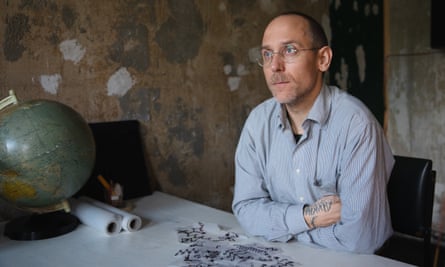
Over the years, I’ve come to see tattoo-getters in three categories: those who just walk into a streetshop one afternoon to have a good time are the majority. Then there are those who seek tattooing as embodiment and celebration, who don’t fear pain. Then there are those who get tattooed to make themselves look better, but have more difficult relationships with their bodies. These people transform their appearances in order to have some control, and then engage with the pain as a way of healing. Though I’m not a therapist, I, too, have much personal experience of healing from trauma, gender abuse and queerness.
My studio is safe and private. I use it for my personal recovery and meditation. I tattoo one person per day. I usually do this three times a week so there is always room for last-minute appointments. My process is slower. I receive an idea of where they want to place them, their pronouns, and their astrology before they arrive. We usually finish by 7pm, and they arrive at 1pm.
The studio is quiet and peaceful. I keep the noise down. Every pattern I create is unique and never repeated. It’s based on our interactions in person. This is how I want to work: One pattern for one person. We often find new patterns in the moment. To ensure they feel and look balanced, I draw the patterns directly on the body.
I spent my first 12 year in a small town in northeastern Alberta. There, I was conditioned to fear any person with tattoos or who looked different. I was already a fan of music, skateboarding, and addictions when we moved to the closest city in 1992. But I had to conceal my gender identity and queerness.
At the tender age of 15, my drawings were being tattooed upon me and my friends. To fit in and feel like I was cis, I became obsessed with changing my appearance. I was allowed to be at the tattoo shop of a friend who I used to sell to, and somehow I didn’t overstay my welcome. I was allowed to soak it all in like a sponge.
I was finally sober in 2002. I escaped to Vancouver and had essentially finished having most of my body altered by 2004. Although I was offered an apprenticeship, my restlessness kept moving me: Toronto, Montreal and LA. New York Toronto again. 2013 was my first year in Berlin. I still travel the world tattooing at an insane pace. I burned out five years ago.
My body was screaming at my before I came out as a nonbinary transperson in 2017. But, I didn’t understand. I was saved by this colourful, dysphoric suit of armour. I am aware of the impact tattoos have on the lives and health of others. I am slowly adding affirming tattoos from close friends. The spaces between are still highly desired.
The body’s physical language supersedes our verbal communication – when sharing a tattoo ritual, these boundaries can be subtle. I have had to learn how to care for myself while tattooing. I’ve also struggled through years without success, and the scars prove it. My clients will always remember that they had a safe experience when they leave the studio. That is my hope.